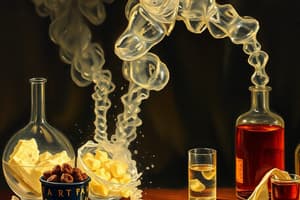Podcast
Questions and Answers
What is the purpose of adding charcoal during the recrystallization process?
What is the purpose of adding charcoal during the recrystallization process?
- To increase the boiling point of the solvent
- To accelerate crystal growth
- To dissolve the solid sample
- To adsorb colored impurities (correct)
Cooling the solution quickly is essential for proper crystallization.
Cooling the solution quickly is essential for proper crystallization.
False (B)
What method can be used if no crystals are formed during recrystallization?
What method can be used if no crystals are formed during recrystallization?
Seeding, scratching, or evaporating some of the solvent.
The use of a _____ funnel helps prevent crystallization on the stem during filtration.
The use of a _____ funnel helps prevent crystallization on the stem during filtration.
Match the following steps of recrystallization with their purposes:
Match the following steps of recrystallization with their purposes:
What is the purpose of gravity filtration in the preparation of organic compounds?
What is the purpose of gravity filtration in the preparation of organic compounds?
Vacuum (Buchner) filtration is suitable for hot solutions.
Vacuum (Buchner) filtration is suitable for hot solutions.
What is the main purpose of recrystallization?
What is the main purpose of recrystallization?
The suitable solvent for recrystallization must be __________ and __________.
The suitable solvent for recrystallization must be __________ and __________.
Match the following steps with their correct processes in recrystallization:
Match the following steps with their correct processes in recrystallization:
Which method is NOT used for determining the purity of a compound?
Which method is NOT used for determining the purity of a compound?
Distillation can be used to purify liquid organic compounds.
Distillation can be used to purify liquid organic compounds.
List two conditions required for a suitable recrystallization solvent.
List two conditions required for a suitable recrystallization solvent.
Flashcards are hidden until you start studying
Study Notes
Preparation of Organic Compounds
- Recrystallization is a purification technique for solid compounds at room temperature.
- General Idea: Impure solid is dissolved in a hot solvent, impurities are removed, and a pure solid is obtained upon cooling.
- Process:
- Dissolve the impure solid in a minimum volume of hot solvent with a boiling stone.
- Colored impurities: Add charcoal to the hot solution.
- Filter the hot solution using a fluted filter paper in a pre-heated system.
- Gradual cooling to induce crystallization.
- Vacuum filtration to obtain crystals.
- Wash crystals with a small amount of cold solvent.
- Air-dry crystals before measuring weight and melting point.
- Solvent Requirements:
- Dissolves the substance when hot but re-precipitates it when cold.
- Chemically inert.
- Boiling point lower than the melting point of the solid.
- Notes:
- Boiling stone: Distributes heat evenly throughout the solution.
- Charcoal: Adsorbs colored impurities.
- Pre-heated system: Prevents crystallization on the filter paper.
- Stemless funnel: Prevents crystallization on the stem.
- Gradual cooling: Encourages proper crystal formation (nucleus formation, growth).
- If no crystals form:
- Seeding: Add a crystal as a nucleation point.
- Scratching: Scratch the container to encourage nucleation.
- Evaporate solvent: Reduce the volume to increase concentration.
- If no crystals form:
- Other purification methods:
- Gravity filtration: For hot solutions, used to obtain the filtrate.
- Vacuum (Buchner) filtration: For cold solutions, used to obtain the precipitate.
- Distillation: Purification technique for liquids.
- TLC (Thin Layer Chromatography): Determination of purity by analyzing the separation of components.
Recrystallization Procedure
- Step 1: Dissolve the solid sample in a minimum volume of hot solvent with a boiling stone.
- Step 2: If the solution appears colored, add a small amount of charcoal to the hot but not boiling solution.
- Step 3: Filter the hot solution through a fluted filter paper in a pre-heated system.
- Step 4: Cool the solution gradually to room temperature, then in an ice bath to induce crystallization.
- Step 5: Recover the formed crystals by vacuum filtration.
- Step 6: Wash the crystals with a small amount of cold solvent.
- Step 7: Allow the crystals to air-dry completely before weighing them and determining their melting point.
Studying That Suits You
Use AI to generate personalized quizzes and flashcards to suit your learning preferences.




